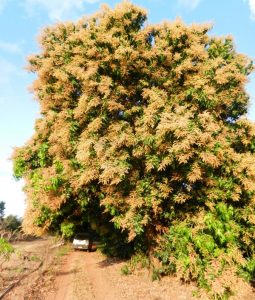Every garden needs trees, for shade, for privacy, for the wildlife, for drama and texture and beauty. But often it is hard to decide which trees you can fit in your garden space. We all want trees that flower, and have nice leaves, maybe deciduous trees, so the winter light can brighten up the garden – but then on the other hand we also want fruit trees, so we can grow our own, particularly fruit that maybe you can’t buy so easily, or for just the pleasure of growing your own.

Huge mango tree – that car’s no toy!
Fortunately many of the tropical fruit trees are also beautiful specimens, and are worthy of a place of honour in your garden – not just in the back corner of the vegie patch. First of all, a mango tree is a must. Generally speaking these can be enormous trees, and the one in this photo truly is – it has never been pruned at all, and is a magnificent specimen, but possibly a bit large for the average garden. However, mango trees can be very severely pruned if you have limited space. The commercial growers prune their trees to a very large hedge every year, since this makes the picking easier and safer. Having pickers doing a ‘Tarzan’ act in the tree tops didn’t sit too well with the OHS people, so pruning was the answer – you can even espalier a mango tree on wires to make a screen – they are very adaptable. I would recommend that you plant a grafted tree, to be sure of the fruit quality – ‘Nam Dok Mai’, is a smaller growing Thai variety with creamy flowers; the fruit is pale cream when ripe, but can be eaten when green, like a crisp apple. ‘Irwin’ has darker red flowers and purple skinned long fruit. There are hundreds of varieties to choose from, as well as the commercial varieties. They often do not come true to type from seed, hence my advice to use a grafted tree.

Pretty pink carambola flowers & 5-corner fruit
Another fruit tree which is worth a place in any garden is the Carambola, or 5-corner fruit tree. It is a tallish tree with fine leaves and pendulous branches, which are covered several times a year with pretty little pink flowers, followed by very attractive golden fruit. This tree too, can be pruned to suit its location.

Cainito foliage, with its bronze leaf reverse
And then there is the Cainito, or star fruit (so-called because the seed arrangement inside is in the shape of a star). This is a very beautiful fast growing tree, with tasty, juicy fruit with a flavour reminiscent of peach. But the foliage is its year round attraction – dark olive green on top and glistening bronze underneath. They can be shaped to produce a broader tree, or left to grow in their normal, quite tall shape. The branches are pendulous, and when the wind catches the leaves, the ripple of green and bronze is quite stunning.
All these three fruit trees are fast growing, with pretty flowers, attractive foliage, and more importantly, all are relatively pest free, and can be pruned to a suitable size for your garden.
My photos:
This mango tree is about thirty years old and huge – that isn’t a toy van parked under it. Mango trees are usually pruned to more manageable sizes however.
Carambola flowers in closeup – note the green fruit hanging on the right. These trees flower and set fruit from the bark, as well as from the tips of the growth, which means you can prune it without losing a crop of fruit.
Cainito foliage, showing the contrast between the bronze reverse and the green surface of the leaves. The flowers are small, bronze and white, and come from the growing tips, so pruning should be done after fruiting.
